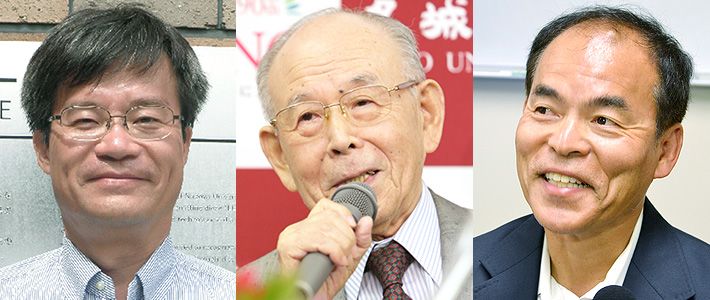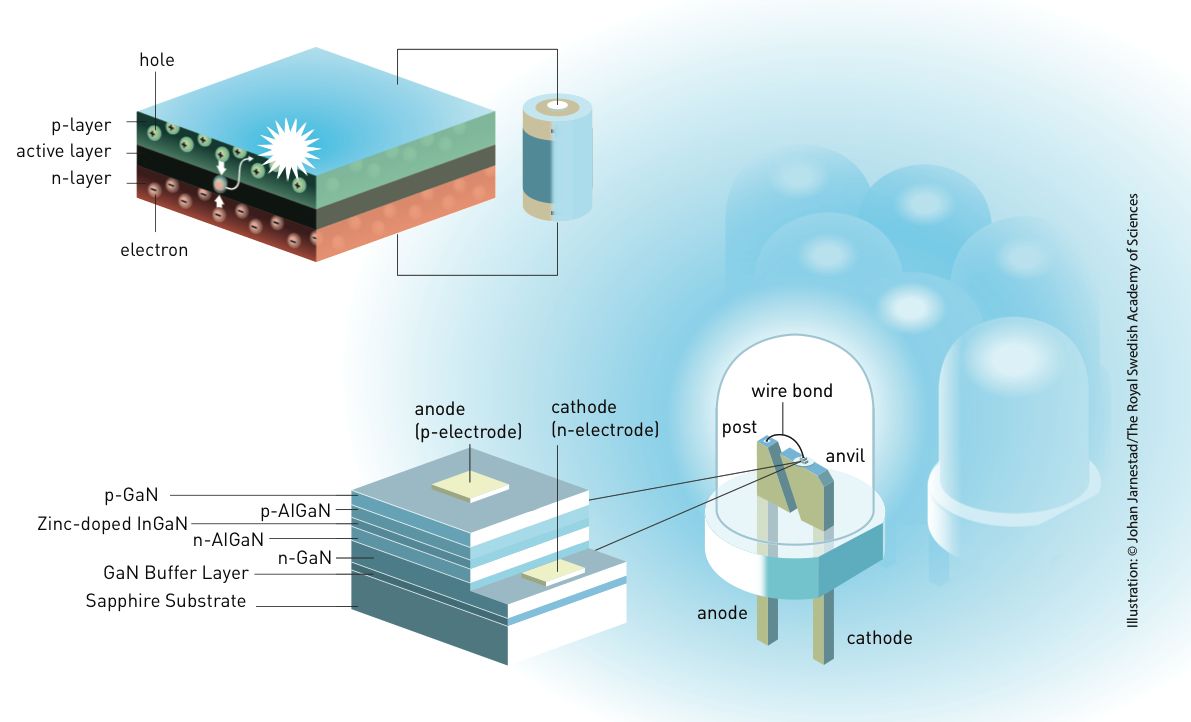
Physics Nobel Goes to Three Japanese Researchers
Science Technology- English
- 日本語
- 简体字
- 繁體字
- Français
- Español
- العربية
- Русский
On October 7, the Royal Swedish Academy of Sciences announced the winners of the 2014 Nobel Prize in Physics. Sharing the prize were three Japan-born scientists: Distinguished Professor Akasaki Isamu and Professor Amano Hiroshi of Nagoya University and Professor Nakamura Shūji of the University of California, Santa Barbara.
The three won the prize “for the invention of efficient blue light-emitting diodes which has enabled bright and energy-saving white light sources.” LEDs are not a new technology, having existed since the 1950s, but for many years mass-produced diodes could only emit light in the range from infrared to green. Blue LEDs, needed to produce white light for illumination, remained out of reach until the three Japanese researchers tackled the problem.
New Techniques for New Light
At the heart of an LED is a structure with three layers: an n-layer with a surplus of electrons, a p-layer with insufficient electrons (or “holes”), and an active layer sandwiched between them. When electricity is applied to the layers, it drives electrons from the n-layer and holes from the p-layer into the active layer, where they recombine to produce light.
 The basic structure of an LED and the GaN layers that go into the blue LED. (Illustration © Johan Jarnestad/Royal Swedish Academy of Sciences.)
The basic structure of an LED and the GaN layers that go into the blue LED. (Illustration © Johan Jarnestad/Royal Swedish Academy of Sciences.)
The scientists’ first breakthrough came in 1986, when Akasaki and Amano successfully created high-quality gallium nitride (GaN) crystals. GaN had long been considered an ideal substance for the blue LED, but creating the diode’s layers—particularly p-layers—from it was a tall challenge. Akasaki and Amano placed a layer of aluminium nitride on a sapphire substrate; this proved an ideal base on which to grow high-quality GaN. In the late 1980s they succeeded in creating a p-layer with GaN, leading to their first bright blue LED, which they showed to the world in 1992.
Nakamura, meanwhile, began his blue LED work in 1988. In 1990 he arrived at the technique of growing a first GaN layer at low temperature and then growing additional layers at higher temperatures. By perfecting his thermal annealing method, a much simpler technique than the electron-beam irradiation used by the Nagoya University team, he enabled the mass production of GaN p-layers. As a result of his work, the first LED light bulbs emitting bright white light appeared in 1993.
A Range of Applications
The blue LED can be used in combination with red and green—or more commonly, together with a yellow phosphor layer—to produce white light. LED light bulbs, which produce 300 lumens per watt, are much more energy efficient than the incandescent bulbs (16 lm/W) and fluorescent lamps (70 lm/W) they are increasingly replacing. While considerably more expensive than traditional filament bulbs, they can last more than 40 times as long. Hopes are high that rapid uptake of these eco-friendly bulbs around the world will dramatically reduce energy consumption.
Blue LEDs are an integral part of other devices. Akasaki, Amano, and Nakamura also worked on a blue laser with a tiny blue LED at its heart. This tight-beam laser produces light with a very short wavelength, making it perfect for reading the densely packed data on a Blu-ray disc. Blue LED devices and their brilliant white light have also found a home on millions of mobile phones, where they serve as camera flashes; in street signs visible from farther off and even in bright sunlight that washes out the light from conventional traffic signals; and in lightweight flashlights and headlamps that can illuminate the surroundings with much smaller batteries than their incandescent-bulb predecessors. And ultraviolet LEDs, the next step building on blue LED technology, are already being put to work sterilizing polluted water to make it potable.
The Rewards for Their Research
While Akasaki and Amano did their work as academics, Nakamura was a corporate researcher at Nichia Corp., a chemical engineering firm headquartered in Tokushima that is the world’s leading LED supplier. His pursuit of GaN-based LED technology was not seen as promising, and many people in Nichia thought the company’s funds should go elsewhere than his diode research, but he had the support of company founder and president Ogawa Nobuo.
It was a bet that paid off handsomely for the company, but not for Nakamura, who received a bonus of just ¥20,000 for his invention. When he left in 1999 to take a teaching position at UC Santa Barbara, he noted the lack of an environment in Japanese companies for nurturing and supporting motivated researchers as one factor behind his decision. He later sued Nichia for a greater share of the profits his research led to. Following a lower court decision awarding him an astounding ¥20 billion—roughly a third of what Nichia was estimated to have made off of the patents for his inventions—he settled with the company in January 2005 for ¥840 million.
Drama aside, the Nobel Prize is well deserved by the three Japan-born researchers. (Nakamura, 60, took American citizenship after moving to California.) Akasaki, now a professor at Meijō University, is 85 years old, making him the senior by far of the 54-year-old Amano; he will no doubt be pleased to see his achievements recognized during his lifetime. More than 20 years after their discovery appeared on store shelves in the form of LED light bulbs, the three have been honored with science’s highest award.
(Banner photo: Amano, Akasaki, and Nakamura, winners of the 2014 Nobel in physics. Amano photo provided by WAO Corporation. Photos © Jiji.)
science LED Nobel physics Akasaki Isamu Amano Hiroshi Nakamura Shuji